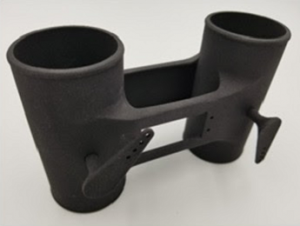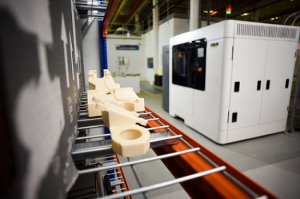GKN Aerospace’s first repair facility in Malaysia focused on 3D printing
3D Printing News Briefs: September 8, 2018
We’re starting out with a lot of business news in today’s 3D Printing News Briefs, and then finishing up with something cool (pun intended) to get you through the weekend. Link3D launched its new Production Planning System for AM workflows, Carbon has a new medical-grade material, and there’s new 3D printed footwear on Kickstarter. Several US sleep experts have joined the Oventus medical advisory board, HP’s MJF technology is being used to make assemblies, and GKN Aerospace is improving its production times with Stratasys technology. Bradley Systems has suggested using its Yellow Magic 7 to clean your SLA 3D printers. Finally, a mechanical engineer and 3D printing blogger has created a retro air cooler.
Link3D Launches Production Planning System
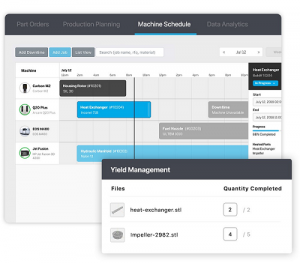 New York City-based Link3D, which offers a centralized software platform for the industrial 3D printing workflow over external or internal additive manufacturing, has just announced the availability of its Production Planning System (PPS) and Advanced Build Simulation. PPS, an AM scheduling solution meant to enhance the company’s software for shop managers and application engineers, can further optimize AM workflows, helping 3D printers to run more efficiently and automate various tasks, like tracing and tracking a build’s genealogy, planning out each step of a build, managing scheduling, facility capacity, and production dispatching, and forecasting accurate production lead times.
New York City-based Link3D, which offers a centralized software platform for the industrial 3D printing workflow over external or internal additive manufacturing, has just announced the availability of its Production Planning System (PPS) and Advanced Build Simulation. PPS, an AM scheduling solution meant to enhance the company’s software for shop managers and application engineers, can further optimize AM workflows, helping 3D printers to run more efficiently and automate various tasks, like tracing and tracking a build’s genealogy, planning out each step of a build, managing scheduling, facility capacity, and production dispatching, and forecasting accurate production lead times.
“Our comprehensive predictive models are made to forecast AM production and costing outputs by accounting for labor, hardware model, AM technology, post-processing and including material science variables like specific gravity and viscosity. Link3D PPS utilizes machine learning algorithms to make recommendations for placing work orders on the correct machines based on machine availability to achieve real-time distributed manufacturing,” said Shane Fox, the CEO and Co-Founder of Link3D.
Link3D PPS will use blockchain technology to trace and track all of the data logged and generated, so organizations can validate and certify their production processes.
Carbon Introduces New Medical-Grade Material
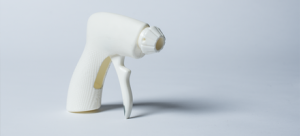 This week, Carbon announced the launch of its first medical-grade 3D printing material, a two-part, white polymer resin called Medical Polyurethane 100 (MPU 100). The material is made for drug- and skin-contact devices, medical system components, single-use medical device, and surgical instrument applications. The material is sterilizable, biocompatible and has good mechanical strength. MPU 100 has good abrasion resistance, is compatible with common disinfectants, and works with the company’s Digital Light Synthesis (DLS) technology to produce rigid, isotropic plastic parts.
This week, Carbon announced the launch of its first medical-grade 3D printing material, a two-part, white polymer resin called Medical Polyurethane 100 (MPU 100). The material is made for drug- and skin-contact devices, medical system components, single-use medical device, and surgical instrument applications. The material is sterilizable, biocompatible and has good mechanical strength. MPU 100 has good abrasion resistance, is compatible with common disinfectants, and works with the company’s Digital Light Synthesis (DLS) technology to produce rigid, isotropic plastic parts.
“The life sciences and medical device industries show enormous promise for using 3D printing for production at scale, and we will continue to prioritize the development of next-generation materials in this segment,” said Jason Rolland, Vice President of Materials at Carbon.
Carbon is offering MPU 100 in 800 ML cartridges to its customers in Europe, the US, and Canada. You can learn more about the new medical-grade material at Carbon’s booth #431505 in the West Hall at IMTS 2018 next week.
Unis Brands Starts 3D Printed Footwear Kickstarter
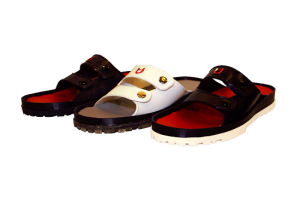 Earlier this week, Unis Brands began a Kickstarter campaign for its line of user-customizable, 3D printed footwear. The line includes two different styles of sandals: the U-Straps and the U-Slides, both of which will be available, in limited quantities, to early campaign backers for just $75 and $100, as opposed to the regular retail price of $140. The 3D printed U-Straps and U-Slides offer custom sizing, as customers provide the exact length and width measurements of each foot. The sandals are made with flexible 3D printing filament for a comfortable fit, and each one has five components, including the logo, buttons, cushion, upper, and midsole, that can be customized with different patterns and colors.
Earlier this week, Unis Brands began a Kickstarter campaign for its line of user-customizable, 3D printed footwear. The line includes two different styles of sandals: the U-Straps and the U-Slides, both of which will be available, in limited quantities, to early campaign backers for just $75 and $100, as opposed to the regular retail price of $140. The 3D printed U-Straps and U-Slides offer custom sizing, as customers provide the exact length and width measurements of each foot. The sandals are made with flexible 3D printing filament for a comfortable fit, and each one has five components, including the logo, buttons, cushion, upper, and midsole, that can be customized with different patterns and colors.
Unis said, “After getting my start in footwear by taking popular sneakers apart, customizing them, putting them back together and then selling them on eBay, I’m excited to announce my first line of sandals on Kickstarter. With five different user-customizable areas, and with individually 3D-printed shoes based on each customer’s exact foot measurements, we are creating footwear that is truly one-of-a-kind.”
All of the company’s recyclable shoes are made in the US on 3D printers designed and built by CEO and founder Nicholas Unis.
US Sleep Experts Join Oventus Medical Advisory Board
 Brisbane medical device company Oventus, known for its FDA-approved, 3D printed sleep apnea device, recently announced that it had appointed a Medical Technology Advisory Board (MTAB) of international sleep experts. The board will assist and guide the company on the development and commercialization of its Sleep Treatment Platform. The MTAB, a US-based consultative advisory body, will report to Oventus CEO Dr. Chris Hart, and provide guidance and input into the company’s clinical, developmental, and commercial strategy, which is currently focused on introducing its products to the US.
Brisbane medical device company Oventus, known for its FDA-approved, 3D printed sleep apnea device, recently announced that it had appointed a Medical Technology Advisory Board (MTAB) of international sleep experts. The board will assist and guide the company on the development and commercialization of its Sleep Treatment Platform. The MTAB, a US-based consultative advisory body, will report to Oventus CEO Dr. Chris Hart, and provide guidance and input into the company’s clinical, developmental, and commercial strategy, which is currently focused on introducing its products to the US.
The following top sleep physicians and advisors in the US have been appointed to the Oventus MTAB for a three year term, which is renewable by mutual agreement:
- Lee A. Surkin, MD, FAASM
- Richard K. Bogan, MD, FCCP, FAASM
- Jerry Kram, MD, FAASM
- Mark Hickey, MD, FAASM
- Mark A. Rasmus, MD, FAASM
- Daniel B. Brown, Esq
- Myra G. Brown
Aerosport Modeling & Design Making Assemblies with HP’s MJF Technology
Ohio-based 3D printing service bureau Aerosport Modeling and Design, which has been producing high-quality prototypes, working models, machined parts, and appearance models since 1996, adopted HP’s Multi Jet Fusion (MJF) technology nearly a year ago.
The company uses MJF 3D printing to fabricate assemblies, such as a Butterfly Valve one made of PA 12 Nylon. The original assembly came in 30 pieces and took half an hour to assemble. But by using HP’s 3D printing technology to make it, the total number of pieces was reduced to just four, with only three minutes of assembly. This helped Aerosport lower its production costs by 70%, and its production time by an astonishing 90%.
GKN Aerospace Improving Production Times with Stratasys 3D Printing
This week, Stratasys announced that GKN Aerospace, which serves over 90% of the world’s aircraft and engine manufacturers, is removing design constraints and improving production times for many tooling applications after integrating 3D printing at its Filton manufacturing site. In an effort to lower lead times for production-line tools and create complex parts that can’t be completed with traditional manufacturing, GKN Aerospace invested in a Stratasys F900 Production 3D printer. This decision helped the company achieve “unprecedented levels of design freedom,” as well as a 40% decrease in material waste; production has also gone from several weeks to only a few hours.
Tim Hope, Additive Manufacturing Center Manager at GKN Aerospace, said, “Since integrating the F900, we have dramatically reduced production-line downtime for certain teams and are enjoying a newfound freedom to design complex tools.
“We can now cost-effectively produce tools for our operators within three hours. This saves critical production time, and by printing in engineering-grade thermoplastics, we can produce 3D printed tools with repeatable, predictable quality every time. All while matching the quality of a traditionally-produced tool, and reducing the costs and concessions compared to equivalent metallic tooling.”
Bradley Systems Wants You to Clean Your SLA 3D Printer with Yellow Magic 7
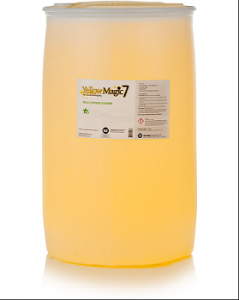 If you’ve got an SLA 3D printer that needs a good cleaning, Bradley Systems, Inc. wants you to consider using its Yellow Magic 7 (YM7) cleaner, as opposed to Isopropyl Alcohol (IPA), which is also called isopropanol and dimethyl carbinol. The company first heard about people using its cleaner, which was originally formulated as a flexo UV ink and varnish cleaner for printing human and pet food packaging, to clean parts for SLA 3D printers on a Formlabs forum, and has since started offering 1 gallon jugs of YM7 on Amazon…and this decision is garnering it some pretty positive reviews.
If you’ve got an SLA 3D printer that needs a good cleaning, Bradley Systems, Inc. wants you to consider using its Yellow Magic 7 (YM7) cleaner, as opposed to Isopropyl Alcohol (IPA), which is also called isopropanol and dimethyl carbinol. The company first heard about people using its cleaner, which was originally formulated as a flexo UV ink and varnish cleaner for printing human and pet food packaging, to clean parts for SLA 3D printers on a Formlabs forum, and has since started offering 1 gallon jugs of YM7 on Amazon…and this decision is garnering it some pretty positive reviews.
“Until now, IPA has been the go-to cleaner for this application because it gets the job done. The downside is that IPA is a flammable chemical compound with a strong odor. This means you’ve got to make sure you’re wearing personal protective equipment (PPE) and storing it properly so you don’t accidentally blow yourself up. As for the smell… well there’s not much you can do there,” the company wrote in a blog post.
YM7, unlike IPA, is biodegradable, non-toxic, and has little odor. It’s not a fire hazard, as it’s water based, and it also performs well in an ultrasonic cleaner. It’s also versatile enough to clean a multitude of different 3D printer parts and accessories, like rollers and rubber pads.
“So, what we’re seeing so far is that you can still get the job done using Yellow Magic 7 without the stink or the potential of blowing up your co-workers or family. Which is nice.”
Mechanical Engineer Builds 3D Printed Retro Air Conditioner
 While 3D printing is a relatively modern technology, it can be fun to use it to recreate your favorite retro items from the past, like arcade games, original Apple computers, FM radios, and television sets…even scuba helmets! A mechanical engineer named Juan, who owns a YouTube channel and blog titled Govaju 3D Printing, has worked in the 3D printing world for eight years, 3D printing is not only his work, but also his hobby and passion. Recently, Juan decided to get back to the past by creating a 3D printed retro item of his own.
While 3D printing is a relatively modern technology, it can be fun to use it to recreate your favorite retro items from the past, like arcade games, original Apple computers, FM radios, and television sets…even scuba helmets! A mechanical engineer named Juan, who owns a YouTube channel and blog titled Govaju 3D Printing, has worked in the 3D printing world for eight years, 3D printing is not only his work, but also his hobby and passion. Recently, Juan decided to get back to the past by creating a 3D printed retro item of his own.
“I recently created this video of a project that I’ve been working on for a few months, it’s a retro air conditioner,” Juan told 3DPrint.com. “It is printed 100% in 3D with the lulzbot taz 6 and with wood filament and PLA.”
Take a look at the video to see the project come together!
Discuss these stories and other 3D printing topics at 3DPrintBoard.com or share your thoughts below.

